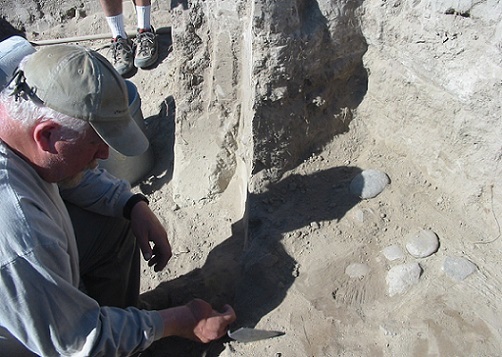Dublin Core
Title
Description
A Salt Lake Valley archaeology site holds clues to that age old question- ‘what’s for dinner?’ The surprising answer may change the way we understand Utah’s ancient past.
For most of us living along the Wasatch Front today, making dinner for our families involves a trip to the grocery store and the use of a microwave. But what if you lived in the Salt Lake Valley 3000 years ago? What would you eat? Where would you find it? How would you prepare and cook it?
Answers to these questions were recently found by archaeologists from the Utah Division of State History, who excavated part of an Archaic-era site in the Salt Lake Valley. Called the ‘Prison Site’ for its proximity to the state penitentiary, the place is yielding fascinating clues as to how families made their living here 3000 years ago.
Archaeologists discovered extremely rare pit houses and cooking hearths at the Prison Site, along with tools for hunting and food preparation. The excavation unearthed grinding stones and fire cracked rocks that fractured when they were heated and dropped into water to cook food in baskets. Razor sharp tools made from obsidian sourced from mines nearly 200 miles away raise questions about travel and trade, while the quantities of crushed animal bone suggest that Archaic people used the site continually for nearly 1500 years.
What foods were eaten at the Prison Site? The usual suspects, such as deer, rabbit, sheep, antelope, snakes, birds, even turtles, as well as grass seeds, sunflower seeds, acorns, yucca, lily bulbs, and wild potatoes. But the most unexpected discovery was that Archaic people were processing and eating corn here as early as 3000 years ago. That’s 1000 years earlier than archaeologists generally think that corn came to the area!
Questions linger about whether corn was grown at the Prison Site, or brought in from a distant source, like obsidian. Either way, the presence of corn in the Salt Lake Valley during this time challenges our understanding about the development of agriculture in Utah and the interactions of groups living in the West at this time.
Who knows what future work at the Prison Site might reveal about Utah’s ancient past?
Creator
Source
Image: Utah's State Archaeologist, Kevin Jones, investigates a cooking hearth discovered during the scientific excavation of the Prison Site, a rare Archaic-era encampment above the Jordan River in Salt Lake County, 2007. Image courtesy Megan van Frank.
_______________
See Yentsch, Andrew T., Ronald J. Rood, Kevin T. Jones, and Lindsay A. Fenner, “Archaeological Investigations at the Prison Site (42SL186),”Antiquities Section Selected Papers, Vol. VIII, No. 17, October 2009; Yentsch, Andrew T., and Ronald J. Rood, “The Prison Site: Evidence for Late Archaic Housepits in the Salt Lake Valley,” Utah Archaeology, Vol. 20, No. 1, 2007, pp. 41-56, retrieved http://utahhistory.sdlhost.com/#/item/000000041001032/view/50; Loomis, Brandon, “Scientists: Don't make ancient site a rail hub,” Salt Lake Tribune, March 2, 2009. Retrieved from http://www.sltrib.com/ci_11821743.

